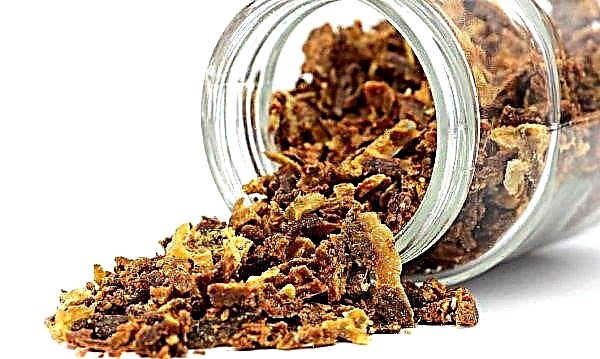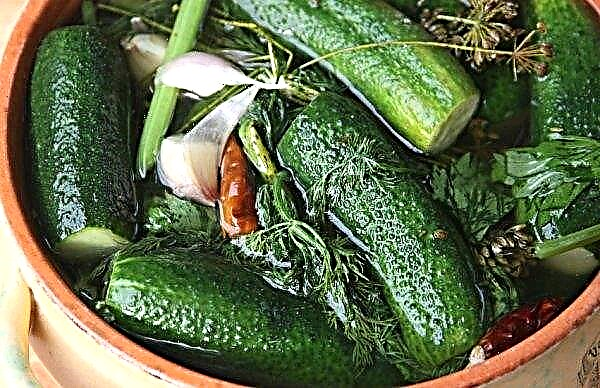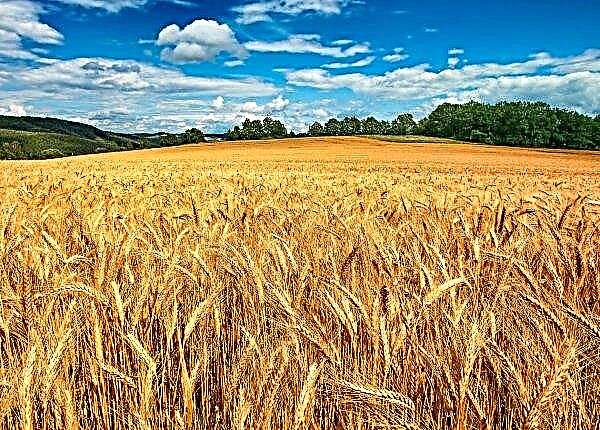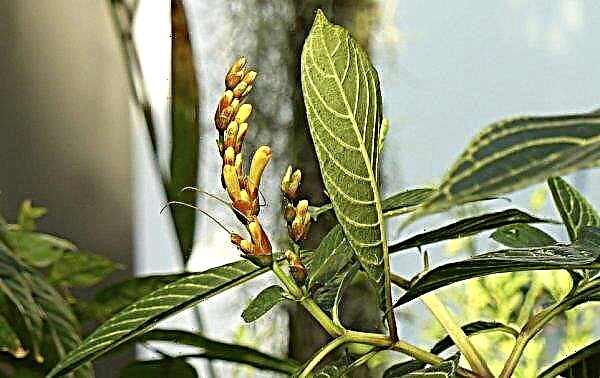Today, lentils are growing in demand from supporters of good nutrition. If you belong to this category of people, you probably noticed that this representative of legumes has varieties. The article will discuss the main types of lentils and their differences.
Types of Lentils: Overview and Description
Lentils vary in color, shape and size of seeds. The last criterion divides the culture into large seed and small seed. The classic and most popular types of lentils are red and green. In addition, there are also black, brown, and yellow lentils. Lentil varieties also exist within each species.
Did you know? The ancient Egyptians laid bags with lentils in the burial places of the pharaohs as early as 4,5 thousand years ago, which indicates their special attitude to this culture.
Each of the species has features:
- BlackIn addition to color and shape, giving it a resemblance to black caviar (for which it is called Beluga), it is also distinguished by the high cost of seeds. They contain up to 35% protein and a substance that gives the seeds a black color, which has antioxidant properties.

- Red It has a light red color, for which it is often called pink. A characteristic feature of the species is the absence of a shell on the grains, so that the product is cooked quickly. Red lentils are among the most popular types and have a wide palette of nutrients with decent taste.

- Green represents the most grown species in our area. Its flat seeds, resembling a plate, gave the second name to this lentil - Plate. Unlike red seeds, the fruits of green lentils are cooked much longer, but they always retain their shape and have a more saturated taste.
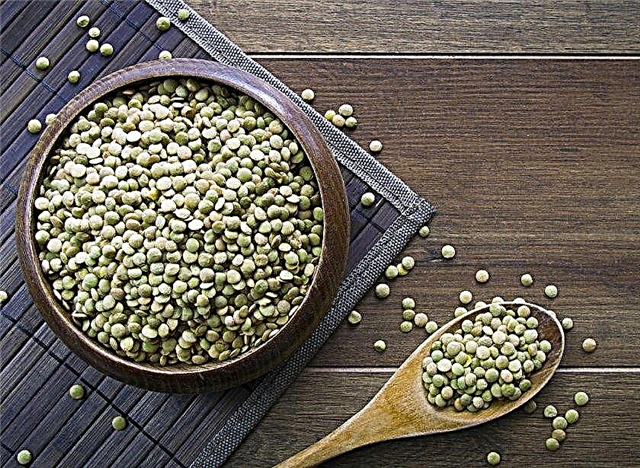
- Yellow It has large seeds with a nutty flavor and delicate aroma. Yellow fruits with a core of red color are in demand.

- Brown is the most common species in the world. Its fruits have a hard shell, which allows them not to boil during the heat treatment. However, brown fruits must be soaked before cooking.

Red and Green Lentils: A Comparative Analysis
These most popular types, with similarities in the chemical composition of grains and the set of nutrients, have significant differences in preparation and some difference in taste.
Chemical composition
The chemical composition of red lentils:
| 100 g of the product contain vitamins in the form of: | In 100 g of seeds, micro and macro elements are presented: |
|
|

Vitamin and mineral composition of green lentils:
| In 100 g of grains there are vitamins presented: | 100 g of fruits contain minerals in the form of: |
|
|

Benefit and harm
Red and green lentils are distinguished by their properties and effects on the human body.
Red lentil
In 100 g of this species, there are:
- calories - 350 kcal;
- protein - 26 g;
- fats - 2 g;
- carbohydrates - 57 g.
- Nutrient saturation and high nutritional value determine the benefits that the human body uses of this product, which is manifested in:
- strengthening the immune system;
- optimization of the circulatory system;
- lowering the level of bad cholesterol in the blood;
- blood pressure stabilization;
- stimulation of the digestive process, due to the presence of fiber;
- cleansing the gastrointestinal tract from poisons and toxins;
- strengthening bone tissue;
- activation of hematopoietic processes, which contributes to the high content of iron in the product;
- stabilization of blood sugar;
- raising the tone of the body;
- improving visual acuity;
- benefits for the proper formation of the fetus in pregnant women;
- beneficial effect on the condition of the skin, hair and nails;
- promoting weight loss.

However, the abundance of useful qualities does not make the product 100% safe. In most cases, this is due not so much to the properties of lentils as to the state of human health.
- Lentils can cause harm when:
- its individual intolerance;
- a tendency to gas in the intestines;
- the presence of kidney stones;
- gout
- low acidity of the stomach.
Green lentils
Nutrition value of this type of lentil:
- calorie content - 323 kcal;
- proteins - 25 g;
- fats - 1.1 g;
- carbohydrates - 53 g.
With almost the same positive qualities that red lentils have, green showed itself well in diseases:
- hepatitis
- pyelonephritis;
- cholecystitis;
- an ulcer;
- hypertension
- rheumatism.
- Besides:
- having an almost daily norm of folic acid in 100 g of fruits, the product has a beneficial effect on the functioning of the central nervous system;
- this acid also prevents the formation of birth defects in newborns;
- the ability to remove poisons from the body makes the product popular in case of poisoning;
- fruit saturation with antioxidants inhibits the cellular aging of the body and protects blood vessels from atherosclerosis;
- a balanced composition of fruits activates metabolic processes in the body;
- the presence of lysine allows the body to synthesize serotonin, rightfully called the hormone of happiness.
The harm from eating green lentils can be done to the problematic organism in the same cases as the red species.

Taste Features
| Red | The taste most resembles peas, albeit with a less harsh aroma. |
| Green | It has a pronounced spicy taste with a nutty tint. |
Important! Lentils have a remarkable ability to not accumulate nitrates, toxins and radionuclides, wherever they are grown.
The main differences
| Red |
|
| Green |
|

Using
The high gastronomic qualities of the plant in question and its unique set of nutrients make it possible to widely use lentils in cooking and in diets aimed at combating excess kilograms, and in developing healthy diets.
In cooking
The ability of green lentils to maintain their shape during prolonged heat treatment allows you to prepare independent dishes, side dishes from it, add it to salads, and to fillings for baking. From it you can prepare dessert dishes, without adding sugar and oil. Red lentil look is perfect as an ingredient for delicious soups, mashed potatoes, cereals, chocolate biscuits and muffins in which it activates the chocolate flavor.

In dietetics
The solid presence of vegetable protein and a low fat content make the product popular with dieters, aimed at getting rid of extra pounds. The presence of fiber stimulates the activity of the gastrointestinal tract, activates metabolic processes and simultaneously inhibits the development of appetite, which contributes to weight loss.
This process is also facilitated by the presence of nicotinic acid (vitamin B3) in the product, which helps break down excess fat. The saturation of the product with iron prevents the depletion of the body during a diet, activating hematopoietic processes.
Did you know? Lentils came to our lands in the 12th century, and since then, with the light hand of the monks of the Kiev Pechersk Lavra, it has become an indispensable attribute of lean food for both monks and ordinary people, and then firmly entered the diet of civilians and soldiers.
In proper nutrition
The ability of lentils not to accumulate harmful substances, regardless of the place of growth, makes it an indispensable product for adherents of proper nutrition. Also, the principles of proper nutrition comply low levels of fat in the product, while it contains high-quality vegetable protein, as well as a balanced set of vitamins, minerals, amino acids and high-quality fiber.

Contraindications
Contraindications to the use of lentils do not arise because of its detrimental properties, but because of the problems existing in the human body. For a healthy person, the product brings nothing but benefit. The harm that lentil fruits can cause to an unhealthy organism has already been discussed above.
In addition, the presence of slow carbohydrates and plant fibers in the product slows down the process of digestion, therefore, with dysbiosis and other problems with the intestines, it should be avoided. It is also not recommended to use lentils for chronic diseases of internal organs and for gout.

How to store lentils?
With proper storage, lentil grains can be stored for a rather long time without losing quality. To do this, it is useful to place them in an airtight container or in containers made of natural fabric. Dried grains should be stored in a cool and dry place. It is important that the fruits are not exposed to light, which destroys their shell. It is also not recommended to store the product in plastic bags in order to avoid condensation, which can lead to rotting of grains.
Important! Lentil kernels should not be stored for more than one and a half years.
Cooked lentils are kept in the refrigerator for no longer than 5 days. In the freezer, the cooked product can hold for six months, and at room temperature for no longer than 12 hours.
Both red and green lentils almost equally worthily represent the bean family. The slight difference that exists only emphasizes the mass of positive qualities that these types of lentils possess.







